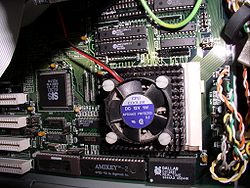
Socket 4
Encyclopedia
Socket 4, presented in 1993, was the first CPU socket
designed for the early P5
Pentium microprocessor
s. Socket 4 was the only 5-volt socket for the Pentium. After Socket 4, Intel switched to the 3.3-volt-powered Socket 5
. Socket 4 does support a special Pentium OverDrive
, which allows running at 120 MHz (for the 60 MHz Pentium) or 133 MHz (for the 66 MHz Pentium).

CPU socket
A CPU socket or CPU slot is a mechanical component that provides mechanical and electrical connections between a microprocessor and a printed circuit board . This allows the CPU to be replaced without soldering....
designed for the early P5
P5 (microarchitecture)
The original Pentium microprocessor was introduced on March 22, 1993. Its microarchitecture, deemed P5, was Intel's fifth-generation and first superscalar x86 microarchitecture. As a direct extension of the 80486 architecture, it included dual integer pipelines, a faster FPU, wider data bus,...
Pentium microprocessor
Microprocessor
A microprocessor incorporates the functions of a computer's central processing unit on a single integrated circuit, or at most a few integrated circuits. It is a multipurpose, programmable device that accepts digital data as input, processes it according to instructions stored in its memory, and...
s. Socket 4 was the only 5-volt socket for the Pentium. After Socket 4, Intel switched to the 3.3-volt-powered Socket 5
Socket 5
Socket 5 was created for the second generation of Intel P5 Pentium processors operating at speeds from 75 to 120 MHz as well as certain Pentium OverDrive and Pentium MMX processors with core voltage 3.3 V. Consisting of 320 pins, this was the first socket to use a staggered pin grid array, or...
. Socket 4 does support a special Pentium OverDrive
Pentium OverDrive
The Pentium OverDrive was a microprocessor marketing brand name used by Intel, to cover a variety of consumer upgrade products sold in the mid 1990s. It was originally released for 486 motherboards, and later some Pentium sockets...
, which allows running at 120 MHz (for the 60 MHz Pentium) or 133 MHz (for the 66 MHz Pentium).


